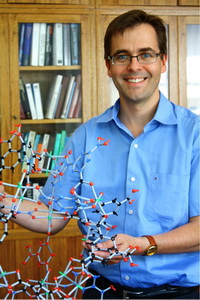SEMINAR
The State Key Lab of High Performance Ceramics and Superfine Microstructure
Shanghai Institute of Ceramics, Chinese Academy of Sciences
中国科学院上海硅酸盐研究所高性能陶瓷和超微结构国家重点实验室
Synthesis and Application of Nanoporous Materials
Speaker
Prof. Dr. S. Kaskel
Inorganic Chemistry Department, Dresden University of Technology, Germany
10:00 AM, 4th Sep., 2013;Room 607#, 2nd Building
Contact Person: Prof. Qian Liu, Tel: 021-52412612
Due to the extremely high gas uptake of novel porous materials they are recently discussed in energy storage applications for hydrogen storage and natural gas in mobile and stationary applications. While hydrogen is only stored to a significant degree at cryogenic temperatures, natural gas can be stored at room temperature in porous materials. Examples are the mesoporous MOFs DUT-6, -9 and -23 (DUT = Dresden University of Technology) with specific surface area up to 4850 m2/g and very high capacity for methane and hydrogen storage while DUT-9 consists of Ni-clusters with open accessible sites and extremely high CO2 adsorption capacity.
By using chiral functionality in three-dimensional porous systems, enantioselective catalysts and separation are obtained with well defined pore structure. A unique feature of metal-organic frameworks (MOFs) is the occurrence of flexible behaviour causing the so called gate effect. Such solids show structural transformations at well defined gas pressure associated with giant gas uptake due to pore opening, a feature un-observed for traditional porous solids such as zeolites and activated carbons.
Today a wide variety of materials from soft polymers to hard ceramics is available with high specific surface areas unattained so far and ordered pore structures. In the carbide-to-carbon transformation porous carbides can be now converted into carbon superadsorbers (CDC) with an inner surface area as high as 3000 m2/g. They are promising components in electrical energy storage in so called supercapacitors or battery systems.
Keywords: Metal-Organic Framework, Porous Materials, Adsorption, Catalysis
Biography: Prof. Kaskel got his PhD in 1997 at University Tübingen, Germany. He is now professor for inorganic chemistry in Technical University Dresden and head of the CVD and thin film department at Fraunhofer Institute of Material and Beam Technology. His research interesting includes synthesis and characterization of porous materials; gas storage; catalysis; nanoparticle synthesis; chemical vapour deposition; wet chemical coating techniques; et al. He has published more than 170 papers in Journals of Angew. Chem., J. Am. Chem. Soc.,Chem. Commun., Carbon, ACS Nano., et al., 4 book contributions, and more than 30 patents.


 沪公网安备 31010502006565号
沪公网安备 31010502006565号